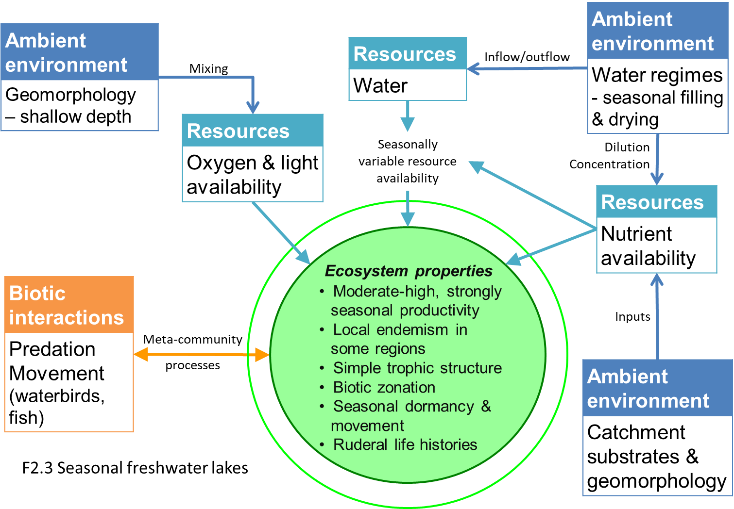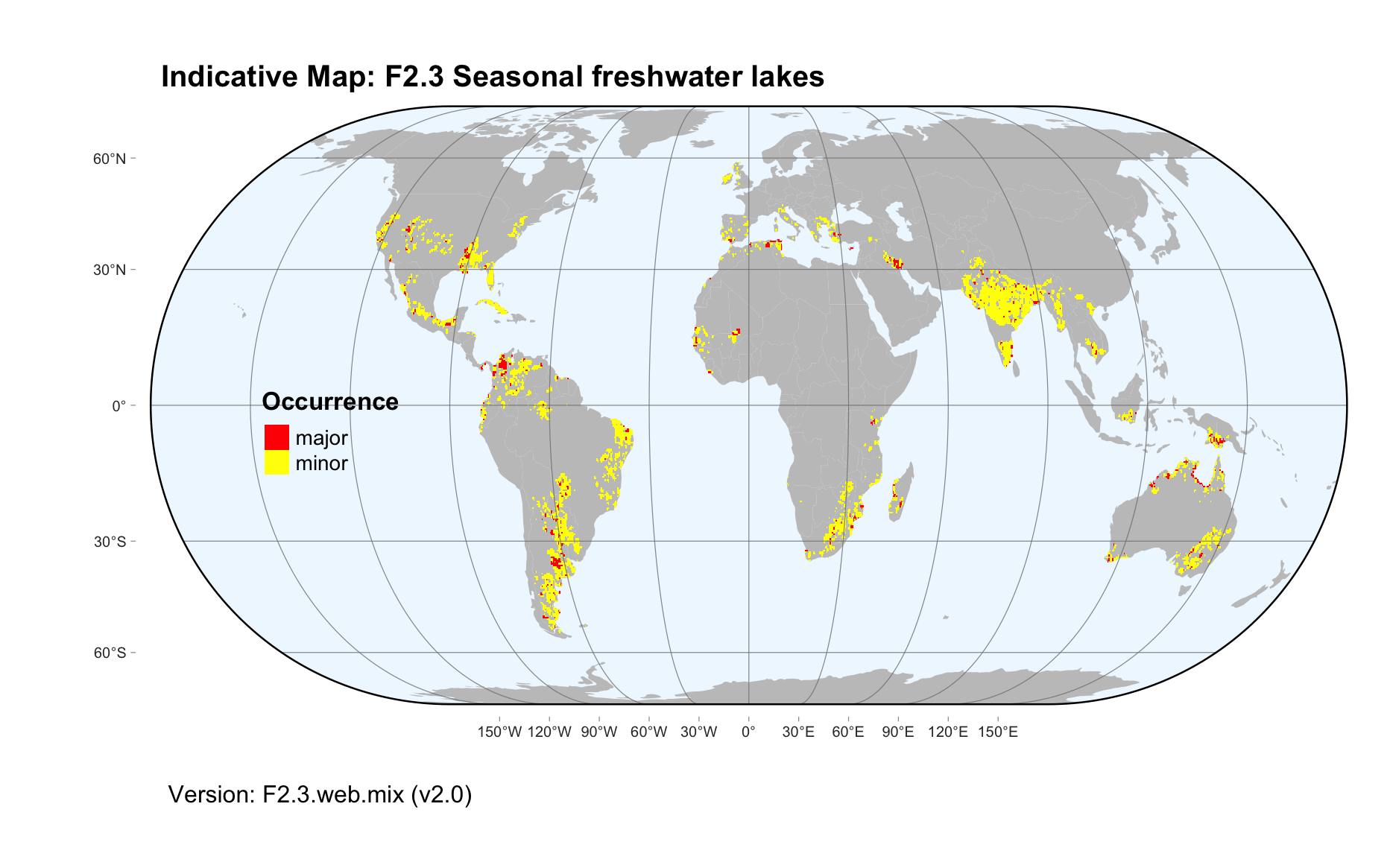Global ecosystem typology
Alternative site for the Global ecosystem typology with additional information for ecosystem profiles and indicative maps.
This site is maintained by jrfep
F2.3 Seasonal freshwater lakes
Biome: F2. Lakes biome
Contributors:
(texts)
Small seasonal lakes, pools and rock holes have plants and animals specialised to seasonally changing wet and dry conditions in temperate and wet-dry tropical regions. Their energy comes mostly from algae and plants. To survive the annual wet/dry cycles, the animals and plants have dormant life stages, such as eggs or seeds, within the lake sediments, or they shelter in damp burrows or other refuges. Plants and animals can build up high abundances during wet seasons, supporting plankton and waterbugs, frogs, birds and mammals but, in most cases, no fish.
Key Features
Mostly small and shallow well mixed freshwater lakes with seasonal patterns of filling and seasonally variable abundance and composition of aquatic biota, including species with dormant life phases and some that retreat to refuges in dry seasons.
Overview of distribution
Mainly subhumid temperate (including Mediterranean-type climate zones) and wet-dry tropical regions.
Profile versions
- v1.0 (2020-01-20): RT Kingsford; RC Mac Nally; DA Keith
- v2.0 (2020-06-24): RT Kingsford; R Mac Nally; MC Rains; B Robson; K Irvine; DA Keith
- v2.01 ():
- v2.1 (2022-04-06): RT Kingsford; R Mac Nally; MC Rains; B Robson; K Irvine; DA Keith Full profile available at official site
Main references
Selected references for this functional group:
Keeley JE, Zedler PH (1998) Characterization and global distribution of vernal pools Ecology, conservation and management of vernal pool ecosystems (Eds ET Bauder et al.). California Native Plant Society, Sacramento.
Rains MC, Fogg GE, Harter T, Dahlgren RA, Williamson RJ (2006) The role of perched aquifers in hydrological connectivity and biogeochemical processes in vernal pool landscapes, Central Valley, California Hydrological Processes 20: 1157-1175
Pettit N, Jardine T , Hamilton S , Sinnamon V, Valdez D, Davies P, Douglas M, Bunn S (2012) Seasonal changes in water quality and macrophytes and the impact of cattle on tropical floodplain waterholes Marine and Freshwater Research 63, 788-800
Diagrammatic assembly model

Maps
Maps are indicative of global distribution patterns are not intended to represent fine-scale patterns. The maps show areas of the world containing major (coloured red) or minor occurrences (coloured yellow) of each ecosystem functional group. See general notes on maps.
There are 2 alternative versions of the indicative map for this functional group, please compare description and sources below.
F2.3.IM.mix_v2.0
Datasets
- HydroLAKES-1.0
- GSW-1.1
- FEOW-2008
Map references
Messager, M.L., Lehner, B., Grill, G., Nedeva, I., Schmitt, O. (2016) Estimating the volume and age of water stored in global lakes using a geo-statistical approach Nature Communications 13603 DOI:10.1038/ncomms13603
Pekel JF, Cottam A, Gorelick N, Belward AS (2016) High-resolution mapping of global surface water and its long-term changes Nature 540, 418-422 DOI:10.1038/nature20584
Abell R, Thieme ML, Revenga C, Bryer M, Kottelat M, Bogutskaya N, Coad B, Mandrak N, Contreras Balderas S, Bussing W, Stiassny MLJ, Skelton P, Allen GR, Unmack P, Naseka A, Ng R, Sindorf N, Robertson J, Armijo E, Higgins JV, Heibel TJ, Wikramanayake E, Olson D, López HL, Reis RE, Lundberg JG, Sabaj Pérez MH, Petry P (2008) Freshwater ecoregions of the world: A new map of biogeographic units for freshwater biodiversity conservation, BioScience 58: 403–414. DOI:10.1641/B580507
F2.3.web.mix_v2.0

Datasets
- HydroLAKES-1.0
- GSW-1.1
- FEOW-2008
Map references
Messager, M.L., Lehner, B., Grill, G., Nedeva, I., Schmitt, O. (2016) Estimating the volume and age of water stored in global lakes using a geo-statistical approach Nature Communications 13603 DOI:10.1038/ncomms13603
Pekel JF, Cottam A, Gorelick N, Belward AS (2016) High-resolution mapping of global surface water and its long-term changes Nature 540, 418-422 DOI:10.1038/nature20584
Abell R, Thieme ML, Revenga C, Bryer M, Kottelat M, Bogutskaya N, Coad B, Mandrak N, Contreras Balderas S, Bussing W, Stiassny MLJ, Skelton P, Allen GR, Unmack P, Naseka A, Ng R, Sindorf N, Robertson J, Armijo E, Higgins JV, Heibel TJ, Wikramanayake E, Olson D, López HL, Reis RE, Lundberg JG, Sabaj Pérez MH, Petry P (2008) Freshwater ecoregions of the world: A new map of biogeographic units for freshwater biodiversity conservation, BioScience 58: 403–414. DOI:10.1641/B580507
Check: the Glossary / Profile structure / the public document